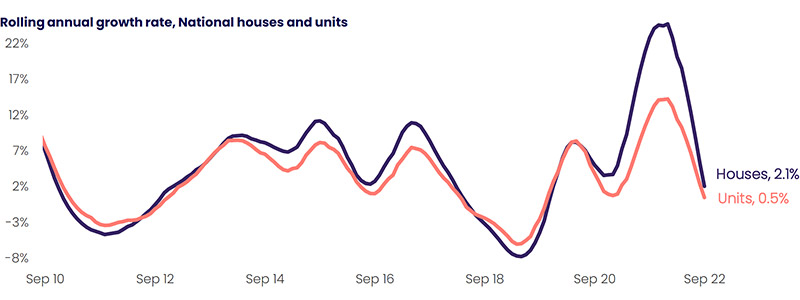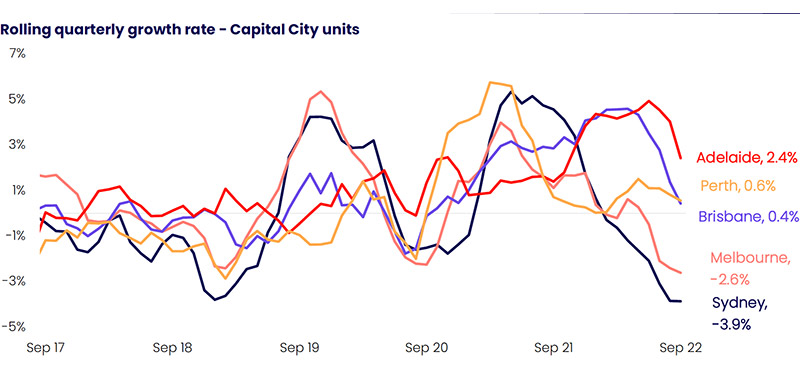Units prove less volatile than houses but still lurch into price fall territory
Units price falls had been limited to the top end of the market but the contagion has spread to more affordable apartments, although there were some capital cities bucking the trend and rent yields across the board continue to surge.
Units have reinforced their reputation for stability relative to house prices, with apartment values falling at almost half the rate of detached homes.
Since peaking in April, house values are now reversing at a more rapid rate, falling 5.3 per cent, while values across the unit sector have declined by a more moderate 3.0 per cent.
When property prices were booming, houses enjoyed double the gains of units but the former’s subsequent fall from grace is also proving more dramatic than the latter.
National house values rose 32.5 per cent between September 2020 and April 2022, while national unit values rose by a milder 16.1 per cent over the same period.
But even in the apartment sector, the contagion is catching on.
Across the country’s capitals, 70.8 per cent of the 982 unit markets analysed in CoreLogic’s Mapping the Market report declined over the September quarter, up from 39.8 per cent over the June quarter.
Monthly value change across the individual capitals ranged from a 1.1 per cent decline across Hobart, to a 0.1 per cent rise in Adelaide.
The steeper decline in house values has seen the annual performance gap between national house and unit values narrow to just 1.6 percentage points in September, with houses up 2.1 per cent over the past 12 months, while unit values are just 0.5 per cent above the levels recorded this time last year.

Source: CoreLogic.
The downwards trend in unit values was generally confined to the upper quartile of the market through the first few months of the down phase, however, the more recent trend has seen value declines become more widespread, spreading to the middle and lower price points of the unit market.
Over the September quarter, unit prices are down 3.9 per cent in the most expensive quartile, 2.2 per cent in the middle quartile and teetering into negative territory for the most affordable quartile, down 0.4 per cent.
There were exceptions.
A later cyclical peak in values across the more affordable capitals has seen unit values across Brisbane (0.4 per cent), Perth (0.6 per cent) and Darwin (1.4 per cent) increase over the quarter, despite values falling on a monthly basis in September (down -0.1 per cent, -0.1 per cent and -0.3 per cent respectively).
Only Adelaide managed growth in the past month. While monthly growth there remains positive, the pace of growth has slowed significantly, according to CoreLogic Economist, Kaytlin Ezzy.
“Adelaide’s relative affordability, coupled with low advertised stock levels, has seen Adelaide’s unit market remain resilient to declining values,” Me Ezzy said.
“With further interest rate rises expected in the coming months, it’s likely Adelaide’s unit market will soon find its peak, before declining.”
At the other end of the scale, the country’s south east was the worst performer for unit prices.
Hobart’s monthly decline of 1.1 per cent saw unit values slip 0.1 per cent below the levels recorded this time last year, while the 1.0 per cent and 0.8 per cent monthly declines seen across Sydney and Melbourne took the annual change to -4.8 per cent and -1.6 per cent respectively.
Interest rates calling the shots
As with the broader real estate market, the outlook for unit values remains linked to the trajectory of interest rates.
Based on the latest inflation data, there’s nothing to indicate the Reserve Bank of Australia’s cycle of interest rate hikes will end any time soon.
The consumer price index rose 1.8 per cent in the September 2022 quarter and 7.3 per cent annually, according to Wednesday’s (26 October) data from the Australian Bureau of Statistics.
“Affordability constraints will push home buyers towards more affordable, higher density living... and demand for units should strengthen.”.
- Tom Devitt, Economist, Housing Industry Association
Despite median unit values across Australia falling by around $19,000 since April, the typical monthly mortgage repayment on a new owner-occupier loan is now approximately $600 higher than before the first rate rise, Ms Ezzy noted.
“With interest rates expected to rise further, it is unlikely unit values will find their floor until interest rates stabilise.
“While falling values have potentially helped some first-home buyers clear the deposit hurdle, with the cash rate now 2.5 percentage points above the emergency low rates seen in April (0.10 per cent), the conversation around affordability is shifting towards mortgage serviceability.
“However, there are some possible tailwinds on the horizon.”
The pace of monthly unit value declines eased slightly in September, from a 0.9 per cent fall recorded in July and August, to -0.7 per cent in September.
“While still early days, this could be a sign that unit values are passing their peak rate of decline.”

Source: CoreLogic.
Investors are also continuing to reap stronger rent yields on units. National unit rents continue to surge, up 1.1 per cent in September, compared to a 0.5 per cent rent rise seen across houses.
Except for Canberra (-0.1 per cent) and Regional Tasmania (-0.3 per cent), each capital city and regional unit market saw rents rise in September.
Brisbane continues to record the strongest monthly increases in rental values, up 1.4 per cent (taking rents 4.6 per cent higher over the three months to September), followed by Sydney and Adelaide, which both saw rents rise 1.3 per cent over the month. Over September, unit rental values rose by 1.2 per cent across regional WA and regional SA, by 1.0 per cent across Melbourne and Darwin and by 0.9 per cent across Hobart and regional Queensland.
Building delays
Strong demand for multi-unit developments amidst serious labour shortages is testing the collective capability of the construction industry.
Multi-unit commencements declined by 6.0 per cent in the June Quarter 2022 to 16,966 but this is still up on the lows of 2020. Improvement has been seen in both high-rise and medium density units.
Unit developers are also competing for workers with the housing sector. With more houses still being commenced than completed, Australian home builders now have 104,228 detached houses under construction, a record pipeline that is 81.2 per cent larger than what existed pre-pandemic.
Housing Industry Association Economist, Tom Devitt, said Australian home builders are still struggling to complete the enormous pipeline of work they accumulated over the last two years.
“Supply constraints will keep Australia’s home builders busy this year and next as they continue to work down this record volume of detached house projects, and in addition to this, the multi-units market is also continuing to strengthen,” Mr Devitt said.
“With interest rates and the cost of building increasing rapidly, affordability constraints will increasingly push home buyers back towards more affordable, higher density living and with the return of migration, demand for units should continue to strengthen.”


















